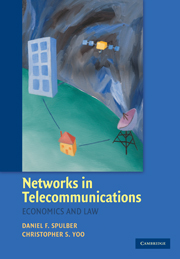Book contents
- Frontmatter
- Contents
- Preface
- Acknowledgments
- Introduction
- PART I THE ECONOMICS OF NETWORKS
- PART II THE REGULATION OF NETWORKS
- 4 Network Regulation Basics
- 5 Economic Effects of Regulating Access to Networks
- 6 Pricing of Access to Networks
- 7 Constitutional Limits on the Pricing of Access to Networks
- PART III POLICY APPLICATIONS
- Conclusion
- Bibliography
- Index
- Table of Cases
4 - Network Regulation Basics
Published online by Cambridge University Press: 05 June 2012
- Frontmatter
- Contents
- Preface
- Acknowledgments
- Introduction
- PART I THE ECONOMICS OF NETWORKS
- PART II THE REGULATION OF NETWORKS
- 4 Network Regulation Basics
- 5 Economic Effects of Regulating Access to Networks
- 6 Pricing of Access to Networks
- 7 Constitutional Limits on the Pricing of Access to Networks
- PART III POLICY APPLICATIONS
- Conclusion
- Bibliography
- Index
- Table of Cases
Summary
The performance of network industries is determined not just by their underlying economics, but also by the manner in which they are regulated. The chapters in this part analyze the impact of regulation on network performance. This chapter begins the analysis by laying out the sources of market failure traditionally thought to justify widespread regulation of the telecommunications industry. It continues by reviewing the regulatory instruments employed to address those source of market failure. It then critiques the validity of those justifications, finding that they are generally based on economic theories and factual premises that are no longer regarded as viable and fail to take into account the full complexity of network behavior.
Chapter 5 offers a more complete description of the five-part system for classifying types of access mentioned briefly in the Introduction and analyzes the impact of each type of access on network capacity, configuration, and transaction costs. Chapter 6 examines the insights that graph theory can provide into the pricing of network access and uses that framework to critique existing approaches to establishing access prices. Chapter 7 considers the constitutional limitations on access imposed by the Fifth Amendment to the U.S. Constitution, which prohibits the taking of property for public use without the payment of just compensation.
- Type
- Chapter
- Information
- Networks in TelecommunicationsEconomics and Law, pp. 119 - 151Publisher: Cambridge University PressPrint publication year: 2009



